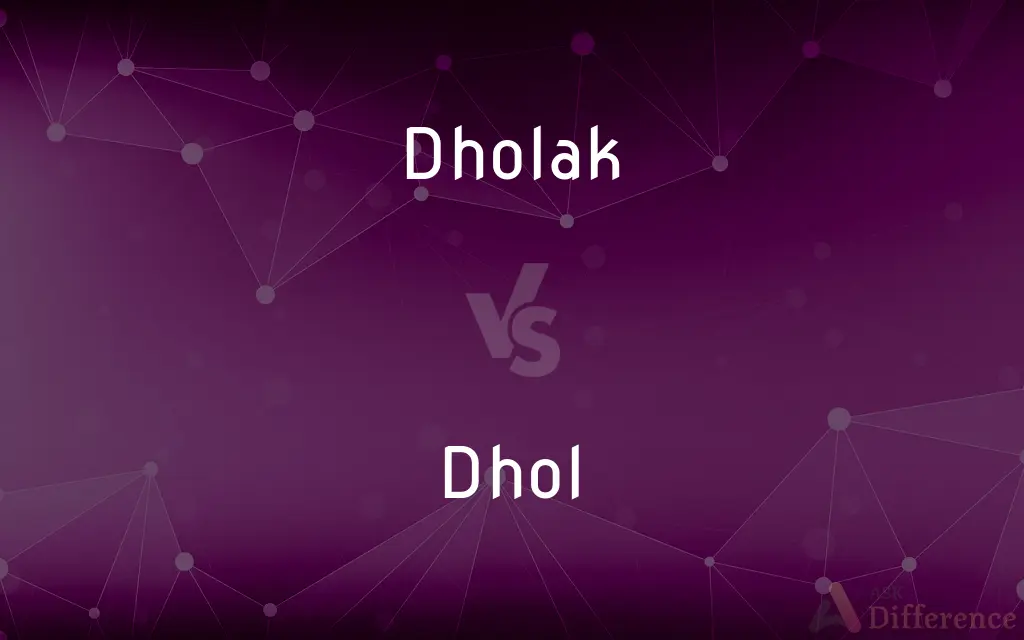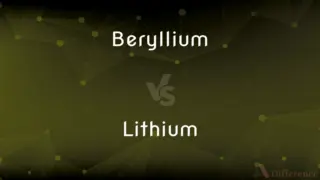Dholak vs. Dhol — What's the Difference?
Edited by Tayyaba Rehman — By Fiza Rafique — Updated on April 8, 2024
Dholak is a smaller, side-played drum used in folk music, while Dhol is a larger, double-sided drum played in festivals and celebrations.

Difference Between Dholak and Dhol
Table of Contents
ADVERTISEMENT
Key Differences
The Dholak and Dhol are both traditional percussion instruments originating from South Asia, but they serve different purposes and contexts in music. The Dholak is a smaller, side-played drum often used in folk and devotional music, whereas the Dhol is a larger, double-sided drum, central to festive and celebratory occasions.
While the Dholak is played using the hands and sometimes with sticks or brushes, offering a softer and more intricate sound ideal for accompanying vocalists, the Dhol is played with two sticks, producing a loud, bass-heavy sound that is perfect for lively dances and processions.
The physical size and design differences between the Dholak and Dhol not only affect their sound and playing techniques but also their roles in performances. The Dholak’s compact size makes it versatile and easy to transport, suitable for intimate settings, while the Dhol’s size and loud sound make it the heartbeat of large-scale celebrations.
Culturally, the Dholak is associated with folk, bhajan, and qawwali music genres, highlighting its significance in storytelling and spiritual gatherings. On the other hand, the Dhol is synonymous with energetic dances such as Bhangra and Giddha, underscoring its role in communal joy and festivity.
Despite their differences, both the Dholak and Dhol share the commonality of bringing people together through rhythm and music. Their distinctive sounds and uses enrich the tapestry of South Asian musical traditions, demonstrating the diverse ways in which drums are integral to cultural expressions.
ADVERTISEMENT
Comparison Chart
Size
Smaller, easier to transport
Larger, more cumbersome
Playing Technique
Played with hands or sticks for softer sounds
Played with two sticks for loud, bass-heavy sounds
Use
Folk and devotional music
Festive and celebratory occasions
Sound
Softer, intricate
Loud, vibrant
Cultural Significance
Associated with storytelling and spirituality
Synonymous with dance and communal joy
Compare with Definitions
Dholak
A small, side-played South Asian drum used in folk and devotional music.
The musician accompanied the singer's performance with the gentle rhythm of the dholak.
Dhol
Played with two sticks to produce a powerful sound.
He played the dhol with such energy that the crowd started dancing.
Dholak
Played with the hands or sometimes with sticks.
The skilled dholak player used his hands to produce a variety of beats.
Dhol
Symbolizes celebration and community spirit.
The loud beats of the dhol signified the start of the community celebration.
Dholak
Traditionally made from wood and animal skin.
The artist chose a dholak made from mango wood for its rich tone.
Dhol
Essential for lively dances like Bhangra.
The bhangra dancers moved in sync with the dhol's beat.
Dholak
Integral to genres like bhajan and qawwali.
The dholak's rhythm was the backbone of the qawwali performance.
Dhol
Carried over the shoulder due to its size.
The dhol player led the parade, carrying the instrument over his shoulder.
Dholak
Known for its versatility in solo and ensemble settings.
Her dholak playing added depth to the musical ensemble.
Dhol
A large, double-sided drum prominent in South Asian festivals.
The sound of the dhol filled the air during the festival procession.
Dholak
The dholak is a two-headed hand drum, a folk percussion instrument. The instrument is about 45 cm in length and 27 cm in breadth and is widely used in qawwali, kirtan, lavani and bhangra.
Dhol
Dhol can refer to any one of a number of similar types of double-headed drum widely used, with regional variations, throughout the Indian subcontinent. Its range of distribution in India, Bangladesh and Pakistan primarily includes northern areas such as the Punjab, Haryana, Delhi, Kashmir, Sindh, Assam Valley, Uttarakhand, West Bengal, Odisha, Gujarat, Maharashtra, Konkan, Goa, Karnataka, Rajasthan, Bihar, Jharkhand and Uttar Pradesh.
Dholak
A North Indian hand drum.
Dhol
(musical instruments) A type of drum from India
Common Curiosities
Can the Dholak be used in large celebrations?
While traditionally suited for smaller settings, skilled players can adapt the Dholak to fit larger celebrations with amplification.
How is the Dhol played?
The Dhol is played with two sticks, producing loud, bass-heavy sounds ideal for lively dances.
What is a Dholak?
A Dholak is a small, side-played drum used in folk and devotional music, known for its soft, intricate sound.
What types of music are associated with the Dhol?
The Dhol is central to energetic dances like Bhangra and festive occasions across South Asia.
Are there specific dances that require the Dhol?
Yes, dances such as Bhangra and Giddha often require the rhythmic support of the Dhol for their lively steps.
Is there a difference in the materials used for the Dholak and Dhol?
Both drums traditionally use wood and animal skin, but the Dholak may incorporate synthetic materials for different sound qualities.
Is the Dholak played with sticks?
The Dholak is primarily played with the hands, but sticks or brushes can also be used for different sound effects.
What makes the Dhol suitable for outdoor events?
Its large size and loud sound make the Dhol perfect for outdoor events, leading processions, and engaging large crowds.
How do the sounds of the Dholak and Dhol differ?
The Dholak produces a softer, more intricate sound, while the Dhol offers a loud, vibrant beat.
Can the Dholak be amplified for larger venues?
Yes, with modern sound amplification, the Dholak can be adapted for larger venues, maintaining its intimate sound on a bigger stage.
What cultural significance does the Dhol have?
The Dhol symbolizes celebration and communal joy, playing a central role in festivals and weddings across South Asia.
Does the size of the Dholak affect its sound?
Yes, the compact size of the Dholak contributes to its softer, more intricate sound compared to the larger Dhol.
Can both drums be played in an ensemble?
Yes, both the Dholak and Dhol can be played in an ensemble, offering a rich blend of rhythms and sounds.
What is the significance of the Dholak in spiritual music?
The Dholak holds a special place in spiritual music, accompanying bhajans and qawwalis, and facilitating a connection with the divine.
How important is the Dhol in traditional music?
The Dhol is immensely important in traditional music, serving as a foundational element for rhythm and dance.
Share Your Discovery

Previous Comparison
Quit vs. Resign
Next Comparison
Beryllium vs. LithiumAuthor Spotlight
Written by
Fiza RafiqueFiza Rafique is a skilled content writer at AskDifference.com, where she meticulously refines and enhances written pieces. Drawing from her vast editorial expertise, Fiza ensures clarity, accuracy, and precision in every article. Passionate about language, she continually seeks to elevate the quality of content for readers worldwide.
Edited by
Tayyaba RehmanTayyaba Rehman is a distinguished writer, currently serving as a primary contributor to askdifference.com. As a researcher in semantics and etymology, Tayyaba's passion for the complexity of languages and their distinctions has found a perfect home on the platform. Tayyaba delves into the intricacies of language, distinguishing between commonly confused words and phrases, thereby providing clarity for readers worldwide.














































